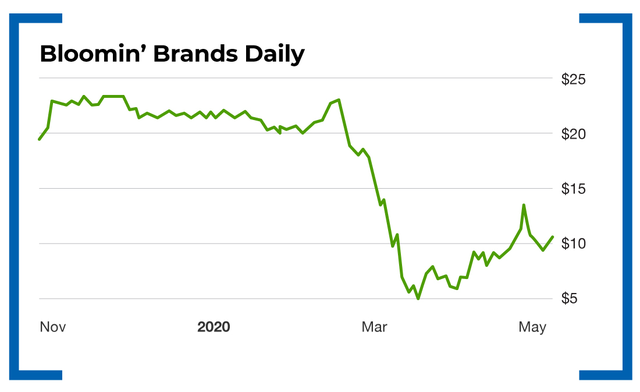Lock In a Profit – Before You Make a Trade
Okay, so it doesn’t work ALL the time.
But in my experience – and that is more than 25 years trading the markets – it works about 80% of the time.
The key is always to position size and only do this type of trade with quality companies that you want to own.
It’s a system I developed in the ’90s, and it’s never failed me.
The system relies on deep-in-the-money covered calls.
This is not a speculative type of trade, but one that falls in line with more “typical” investing, where you are looking to beat the market consistently.
Let me show you how it works with an example of a play we just did in The War Room.
If you’ve been reading Trade of the Day, you know we made 20%-plus on Bloomin’ Brands (Nasdaq: BLMN) last week. It took a few days, and we used a “typical” covered call strategy. But that also meant taking on more risk if the play went south.

This week, I went back to the well with Bloomin’ Brands and took advantage of some hypervolatility.
The company had just made an announcement that it was raising money with a convertible bond offering.
When a company issues a convertible bond, it is saying, “I will pay you a lower interest rate and give you the opportunity to convert the bond into shares.” If those shares are higher at the end of the term, there could be some massive profits in addition to the interest received.
But when the deal is announced, the underwriters never release the actual terms of the deal until a day or two later, after they gauge interest.
That’s when we take advantage of the anomaly. Basically, the market is flying blind. The share price goes down, and the volatility in the options increases. That’s the time to strike.
We bought in at the market. But instead of selling an option above the share price – like “typical” covered call sellers do – we sold an option well BELOW the share price. This can be done when options premiums are elevated across the board.
So instead of buying the shares at $9 and selling the $10 options, for example, War Room members would buy the shares at $9 and sell the $7.50 options. This gives us both downside protection and basically locks in a profit unless the shares trade below $7.50 less the premium received. We may not make as much… but in this market, we must look to the downside as well.
In this case, the $10 option was trading for $1 and the $7.50 option was trading for $2.20. If we sold the $10 option, our cost would be $8 and our upside would be 25% ($10 strike price minus $8) ONLY if the shares closed above $10 at expiration.
By doing the $7.50 option, our cost was $6.80, and the profit potential was 10.2%. But War Room members have less money at risk and will win if the shares stay at the same price, go higher or even go lower. The only way we stand to lose on the play is if the stock drops below our cost, which is almost 25% BELOW its current price.
Action Plan: We see anomalies like Bloomin’ Brands pop up in the market regularly.
“Typical” investors pass them up all the time.
However, my probability calculator places the odds of winning with this trade at more than 83%.
I’ll take that any day.
If you’re tired of being a “Typical Investor” and you want the market to work for you, join us in The War Room now!
[adzerk-get-ad zone="245143" size="4"]About Karim Rahemtulla
Karim began his trading career early… very early. While attending boarding school in England, he recognized the value of the homemade snacks his mom sent him every semester and sold them for a profit to his fellow classmates, who were trying to avoid the horrendous British food they were served.
He then graduated to stocks and options, becoming one of the youngest chief financial officers of a brokerage and trading firm that cleared through Bear Stearns in the late 1980s. There, he learned trading skills from veterans of the business. They had already made their mistakes, and he recognized the value of the strategies they were using late in their careers.
As co-founder and chief options strategist for the groundbreaking publication Wall Street Daily, Karim turned to long-term equity anticipation securities (LEAPS) and put-selling strategies to help members capture gains. After that, he honed his strategies for readers of Automatic Trading Millionaire, where he didn’t record a single realized loss on 37 recommendations over an 18-month period.
While even he admits that record is not the norm, it showcases the effectiveness of a sound trading strategy.
His focus is on “smart” trading. Using volatility and proprietary probability modeling as his guideposts, he makes investments where risk and reward are defined ahead of time.
Today, Karim is all about lowering risk while enhancing returns using strategies such as LEAPS trading, spread trading, put selling and, of course, small cap investing. His background as the head of The Supper Club gives him unique insight into low-market-cap companies, and he brings that experience into the daily chats of The War Room.
Karim has more than 30 years of experience in options trading and international markets, and he is the author of the bestselling book Where in the World Should I Invest?






